
How to Create Captivating Content for Every Stage of the Buyer’s Journey
Creating the right content for your prospects can transform your business. But how do you figure out your buyer’s journey and the type of content your audience is looking for? Here to give you a hand is HubSpot’s Kara Susvilla, an Inbound Professor for the HubSpot Academy.
In this guest post, Kara will help you:
- understand the difference between your buyer’s journey and customer journey
- fine-tune your content creation process to address each stage of your buyer’s journey successfully
- and engage your audience with helpful, sales-boosting content – on repeat.
Let’s see what Kara has to share.
How to define your buyer’s journey
Content is at the core of every successful inbound marketing strategy. It provides the education buyers seek to make an informed purchasing decision and the value organizations aim to give potential customers. For blogs alone, 7.5 million are published every day.
Content shock is here.
Content shock is a term Mark Schaefer – author of Marketing Rebellion – created to explain the massive influx of content online. It’s a fact: content outnumbers people and their availability to consume it. So it’s more important to create high-quality content that stands out from the rest.
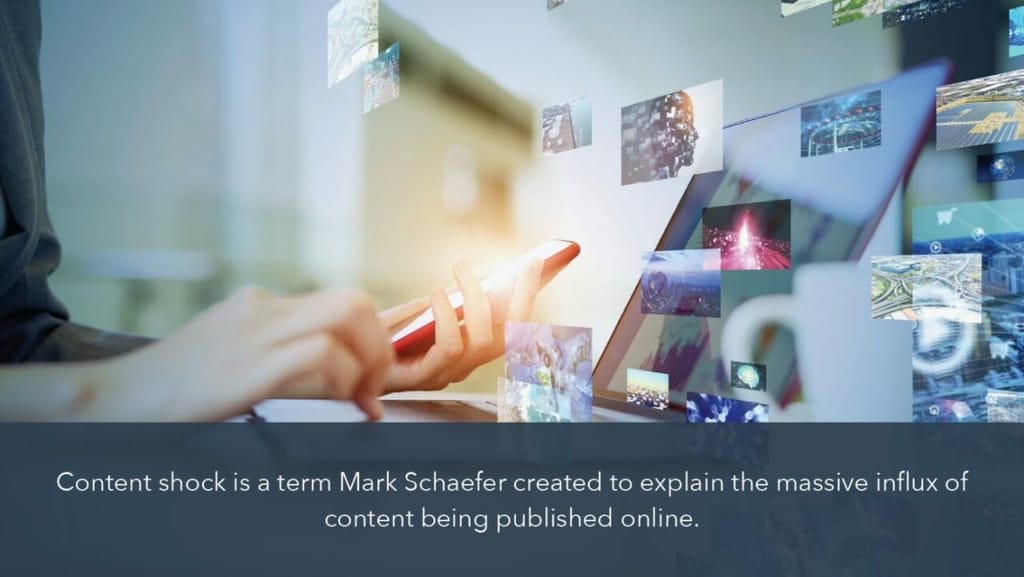
Grabbing the buyer’s attention
How do you get the attention of your target audience?
It starts with identifying your buyer’s journey. Identifying your buyer’s journey is the best way to attract customers. Once you get into the mind of your future customers, it’s easier to convert them into leads. This will also allow you to create content that’s relevant and valuable throughout the buyer’s journey.
The buyer’s journey is the active research process someone goes through leading up to a purchase.
The last time you bought a new item, where did you research it?
How did you determine your options?
What convinced you to choose a certain product over others?
Each of the challenges, questions and goals you developed during your research process was a part of your personal buyer’s journey.
Remembering this journey as you went through it will help you empathize with buyers, and position your content and brand along their path.
“Developing a content strategy based on the buyer’s journey has helped us achieve big wins for clients in many different industries. It led to a tenfold increase in the number of customers. And a software company with a long sales cycle saw a 44% increase in website traffic by creating a mix of content for facilities managers and workplace leaders.
More importantly, the company increased its sales-qualified leads by 83% by setting up email workflows with content that helped them compare their options and validate their decision.”
~ Annie Zelm, content manager at Kuno Creative, a HubSpot Solutions Partner
The buyer’s journey consists of three main stages:
- Awareness
- Consideration
- Decision
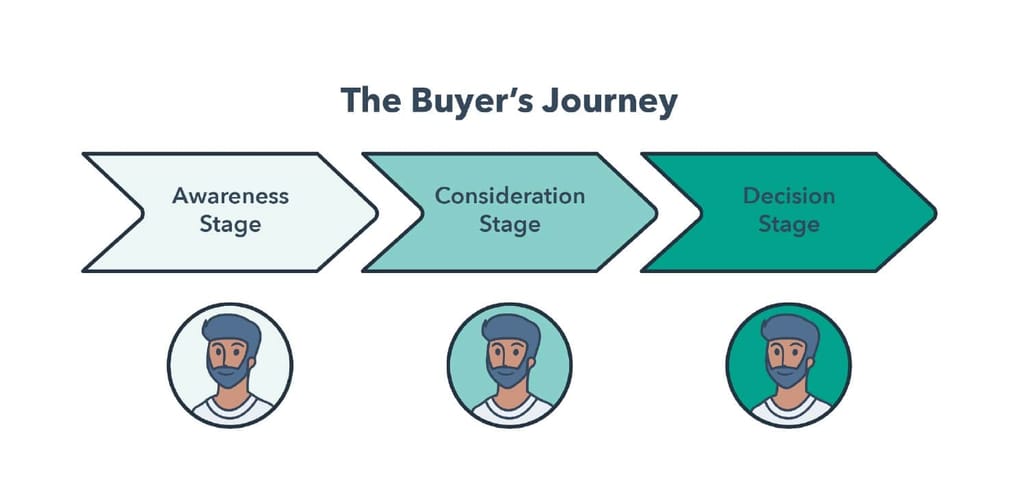
Buyer’s journey vs. customer journey
The buyer’s journey focuses on the stages leading up to a purchase, while the customer journey extends beyond a purchase. We’re going to focus on creating content for the buyer’s journey to help you convert new leads into first-time customers and eventually, clients.
For example, let’s say a fictitious company named SnoozeCity, an online mattress retailer, defined the buyer’s journey for their primary persona:
Side-sleeper Solange has constant back pain the morning. This is the awareness stage. They’re unsure what’s causing the pain, so they Google, “Why does my back hurt in the morning?” They read a few blog articles and watch a YouTube video before learning their mattress may be the problem.

Then, side-sleeper Solange enters the consideration stage as they become aware the mattress is the problem. Eager to find a solution, they take a quiz for assessing the right type of bed products and learn a foam mattress is recommended.
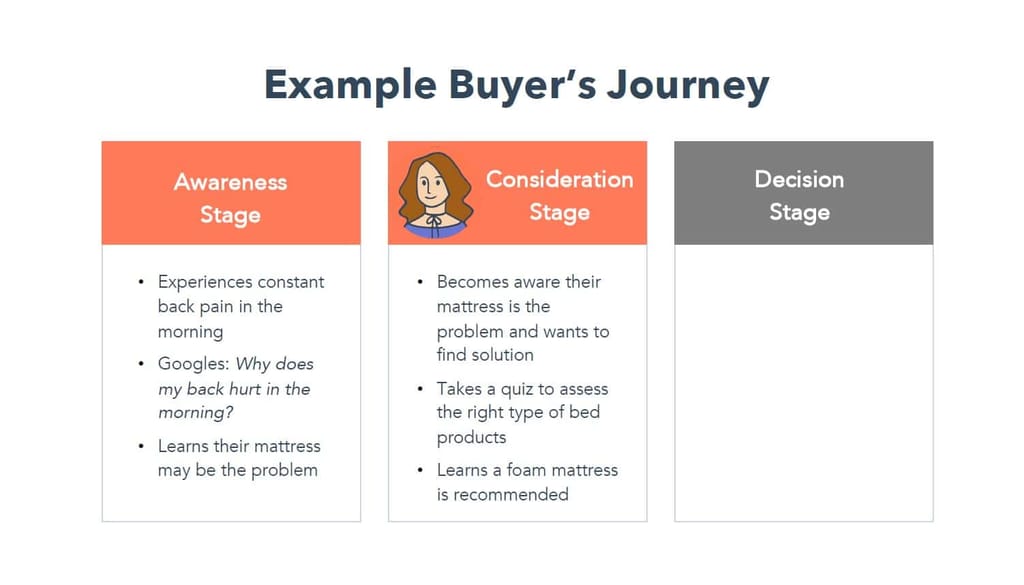
Once they’re informed, they enter the decision stage. They know the solution. They discover several brands offering foam mattresses, and choose a company based on their many 5-star reviews.

As with your business, your buyer’s journey should illustrate customers’ common challenges or goals, and provide content to influence their purchasing decision. Just make sure to focus on one buyer persona at a time.
What is a buyer persona?
A buyer persona is a semi-fictional representation of your ideal customer based on real data and market research. Different personas will often take different paths.
To do so, ask a few questions to define the awareness stage:
- How do buyers describe their challenges or goals?
- What symptoms are your buyers experiencing?
- How do buyers consume content or conduct research?
This will help you understand your buyer’s initial symptoms, problems and how they seek understanding. For example, SnoozeCity’s buyer had back pain and searched Google and YouTube to find out why and how to fix it.
Next, ask yourself these questions to define the consideration stage:
- What are possible solutions to address their challenge or goal?
- How do buyers perceive the pros and cons of each solution?
- How do buyers decide on the right solution?
This will help you understand your buyers’ needs and goals. SnoozeCity’s buyer took a quiz to find solutions to their back pain.
Next, they’ll look for the company to sell them the product.
Ask yourself these questions to help with the decision stage:
- What criteria do buyers use to evaluate the available offers?
- What do buyers like or dislike about your solution compared to alternatives?
- Who needs to be involved in the purchasing decision?
Creating an accurate narrative is one of the most important aspects of defining your buyer’s journey. To get accurate information, consider interviewing customers. Their insights and experiences can inform your narrative.
Annie said:
“We start by conducting interviews with our clients and their customers to better understand the challenges they face, how they search for solutions and what factors they use to compare their options.
These conversations give us important insights about what motivates them personally and professionally.
Thus, we learn how to speak their language, answer their most pressing questions and deliver the right type of content to them through the right channels.”
As a new company, consider interviewing industry experts. Your leadership team or long-time sales team members have a wealth of insight into your prospects.
Consider searching LinkedIn for industry experts from a variety of companies – those outside your network can provide a fresh perspective!
If interviews aren’t an option, research popular blogs in your industry, or look at the content your competitors are creating.
Developing your buyer’s journey is an important first step to creating meaningful content. Your narrative doesn’t have to be perfect, but it does have to be well researched and informed by credible sources.
Once you’ve defined your buyer’s journey, you’ll be able to brainstorm content your audience will find relevant and valuable.
How to brainstorm content for your buyer’s journey
Your buyer’s journey will help you understand your audience’s challenges and goals, and provide guidance for brainstorming new content that provides value to your audience.
- First, identify the topic. What information, education, or value does your content provide?
- Second, identify the format (written, visual, audio)
Identifying your content topic before your format is key to brainstorming content that resonates.
For example, blog posts often work well in the awareness stage, but may not be effective if the topic doesn’t speak to your buyers’ challenges or goals. Focusing on the content topic first will ensure you’re creating impactful content for your buyer’s journey.

How to identify your topic
Creating content for the buyer’s journey means developing content that serves each of the three stages.
Think about the information or opinions your buyer would find valuable in the awareness stage.
Speak to your buyers’ symptoms and problems.
Create content, in the consideration stage, to help your buyers be informed and evaluate the pros and cons of each solution.
In the decision stage, your content helps buyers decide on the right vendor to purchase from. Your content topics and ideas should highlight the value of your solution and convince prospects to choose you.
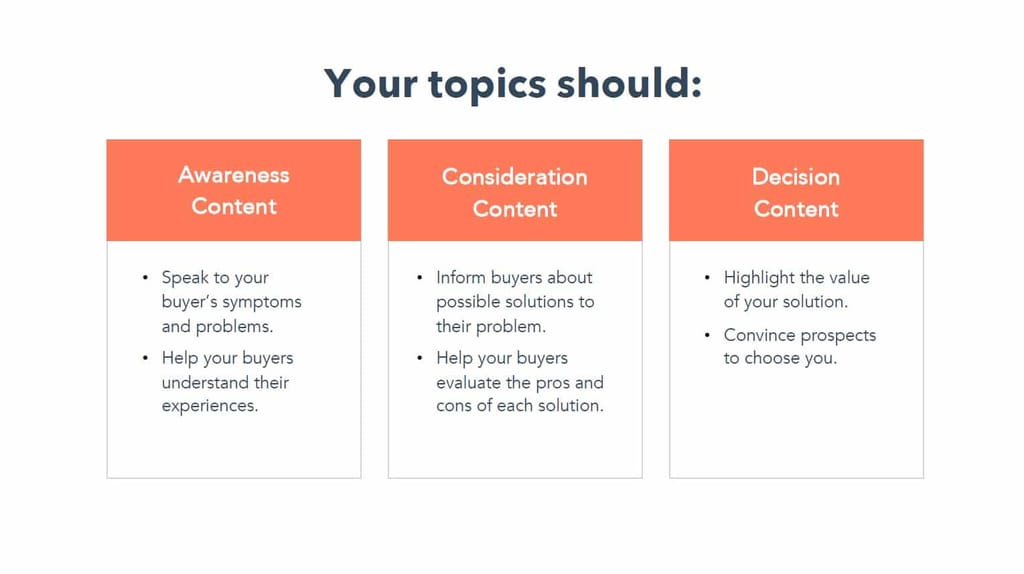
How to identify your format
The most common formats are written, visual, audio and interactive content.
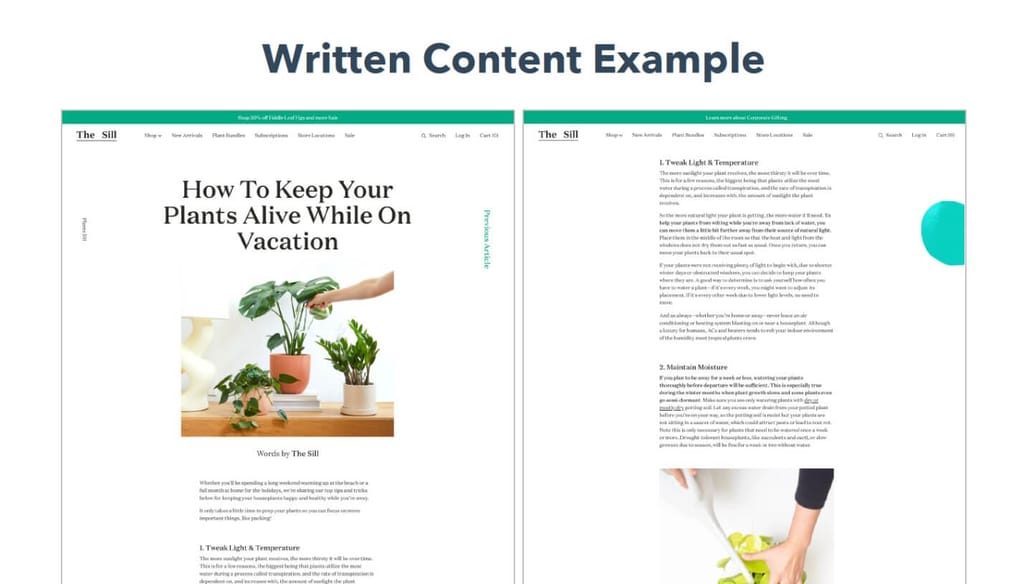
A good example of the written format:
The Sill wrote a blog called “How To Keep Your Plants Alive While On Vacation,” a great example of educational content in the form of a blog post. The written format can utilize keywords and is easier to launch.
Writing is good for new audiences, search engine optimization (SEO) and as a low-lift content creation option.

A good example of the visual format:
The Mint created a video called “Comparing Credit Cards: Which Card Has The Best Interest Rate?” This example illustrates how videos can provide valuable information in a more dynamic format.
Videos require more time and effort compared to written content, but they tend to drive better engagement. Visual is good for presenting your information in a more impactful way.
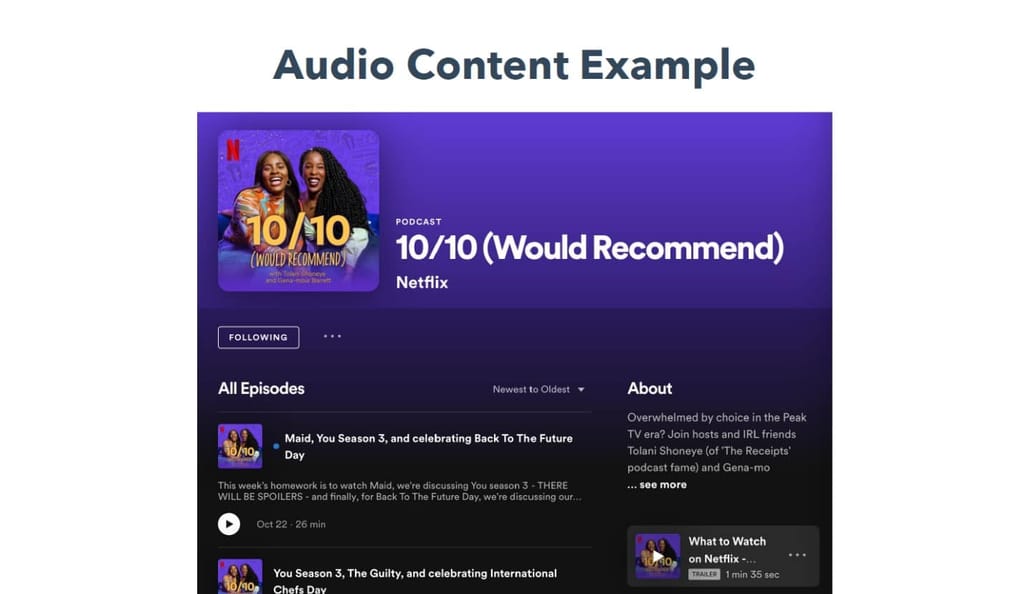
A good example of the audio format:
Netflix UK launched a podcast called “10/10 (Would Recommend)” where the hosts discuss what they’re watching on Netflix and what you should be watching, too.
Audio is good for conversational-type education that’s also entertaining.
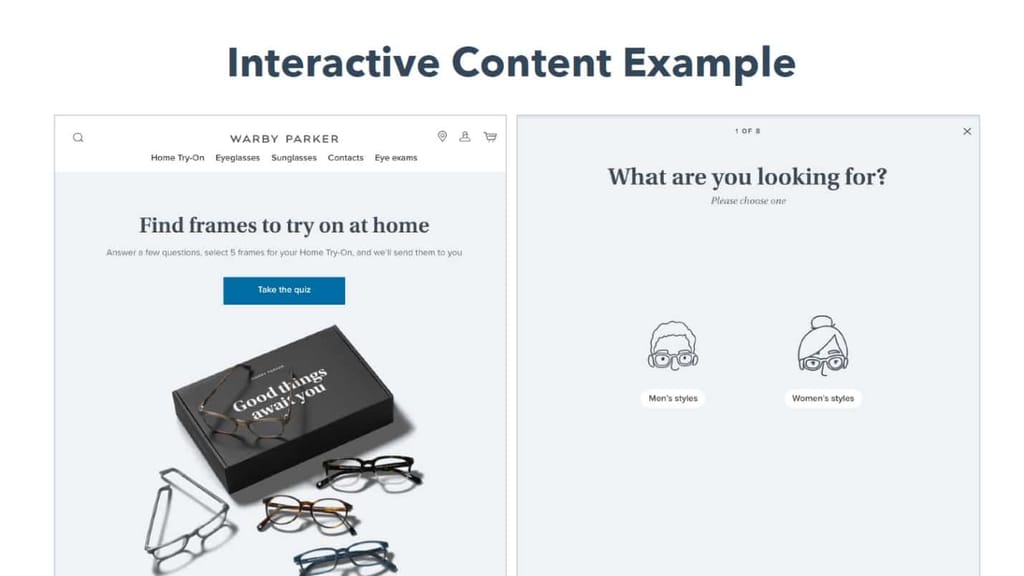
A good example of an interactive format:
Warby Parker, an eyeglasses retailer, created a quiz to help shoppers determine the right frames to purchase and provides recommendations based on their answers.
It gave personalization to buyers. It’s also a great way to turn dull or complicated information into an engaging and interesting experience.
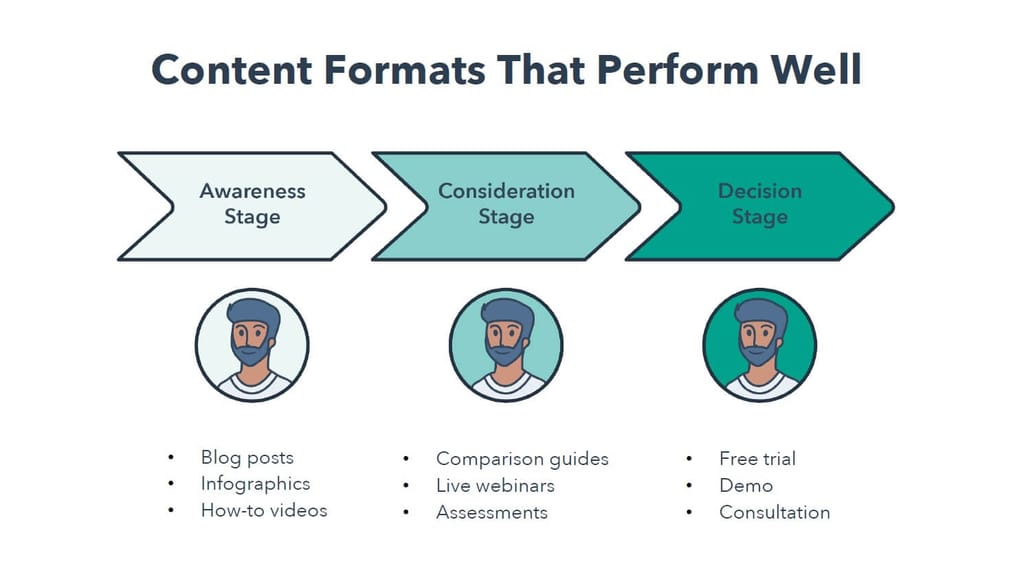
Brainstorming content for each stage of the buyer’s journey will become easier over time, as you learn what resonates with your audience.
How to create content that drives action
The content you create for your buyer’s journey should be educational, as well as encouraging, so leads take action.
Let’s say you’re searching for quick meal ideas online and come across a blog with 20-minute recipes. You continue learning about new recipes as you scroll through the blog until you reach the end. Here, you see an invitation to receive weekly emails about their latest recipes and decide to subscribe. This blog initiated action!
Include a call-to-action in your content.
A call-to-action, or CTA, is an element in your content that prompts visitors to do something.
The recipe blogger asking you to subscribe to their newsletter was a great example of using CTAs. These help you measure the effectiveness of your content, and determine which content is driving the most customers and sales.
As senior marketing manager of audience growth on HubSpot’s blog team, Pam Bump says:
“Pick one or two CTAs that really relate to your post. A high-performing post we’ve published is the “Social Media Trends to Watch in 2022.” We put a variation of calls-to-action in the post but no more than three. Embed in the content, so your reader continues the reading experience without distraction by calls-to-action.”
Use actionable and specific language. For example, consider “Download free template” or “Request a demo” instead of a vague, “Submit.” Design your CTA to stand out. Give it a different color to contrast from the rest of the content.
Jamal Meneide, a video producer for HubSpot’s YouTube team, shares how he created video content that’s driven users to take action:
“A successful video we’ve recently created for YouTube was ‘Why You Need Effective Inbound Content Marketing to Grow Your Brand.’ At the end of the video, we invite viewers to learn more by downloading our free content marketing workbook or taking our content marketing certification. We had amazing results!
Our advice? Create a presentation that is engaging, entertaining and congruent. You don’t want the CTA to be a huge departure from the rest of the content of the video.
If we’re talking about TikTok memes and now you’re trying to get me to buy a subscription to a meal prep service, I’m probably not going to care. Your CTA should maintain the viewer’s expectations and experience of your content.”
Try different types of CTAs – spoken or written – and determine which works best. Experiment with animations, sound effects or contrasting colors to make them stand out.
For podcasts, most platforms allow you to put live URLs that link out to a piece of content – fantastic for getting leads. Consider mid-roll CTAs, for people who skip the beginning or end. Also, consider explaining how to take action through short, concise steps, and shorten your URLs.
Carly Williams, manager of HubSpot’s Content Conversion team, shares her experience with creating interactive tools:
“One of the most successful tools that we’ve launched here at HubSpot is called ‘Make My Persona.’ It’s a buyer persona generator that walks you through strategic questions about your ideal audience. When we launched the tool in 2018, we were featured as the #1 product of the day on Product Hunt and boasted a 17% conversion rate. We exceeded our 30-day lead goal by 200%.”
Consider inviting users to submit their emails. Gather valuable information to provide a personalized experience, such as interactive quizzes or forms. Also, use that information to provide a tailored CTA at the end. Then, use the results from your assessment or tool as the CTA.
For example, if you were taking an assessment to determine why your plant isn’t growing, the results may suggest you aren’t using the right fertilizer. A call-to-action could be to download a comparison guide of different types of fertilizers or to purchase fertilizer from the company.
Your content should incorporate creative and original ideas while speaking to your buyer’s needs and goals, with compelling CTAs.
How to streamline your content creation process
A content creation framework is a structure of processes for publishing content. It allows you to determine what steps and resources you’ll need. It’ll also help your team foster creative ideas in an organized and scalable manner.
Having a process, such as HubSpot Academy’s User Blog, helps your team stay aligned. Frameworks change depending on the type of content you create and the resources available to you.
Follow these three steps to get started:
- Identify your workflow.
- Determine who is responsible.
- Gather your content creation tools.

Identify your workflow
A workflow is an intuitive breakdown of the work needed to complete a project, consisting of the sequence of steps a piece of content takes from its initial creation to its publication.
For example, a blog post workflow may follow these detailed steps:
- First draft complete
- Blog edited ? This is a MUST! It ensures your content is accurate, well-written and aligned with branding.
- Design applied
- Final draft complete
- Post published
Rely on past content to inform steps, considering what went well and what roadblocks you hit.
Determine who is responsible
No matter the content, these are some of the primary roles:
- The content strategy role involves creating a content plan mapped to business needs.
- The writer or producer who creates the content.
- The editor who ensures alignment with your brand, your target market’s needs and your content goals.
- The designing role involves packaging your content in a visually compelling way.
- The distributing role involves publishing or promoting your content.
Gather your content creation tools
You’ll need three main tools:
- A content planning tool
- A content management system (CMS)
- An analytics tool
A content planning tool will help you evaluate your content production schedule, manage multiple content projects and align with all important creators and stakeholders. A CMS is a tool for creating, storing and publishing content online. Analytics tools help you measure the success of your content.
A content creation framework strikes the perfect balance between autonomous creativity and long-term content sustainability. The framework you build today will become the building blocks to scaling your content in the future.
Author: Kara Susvilla is an Inbound Professor for the HubSpot Academy. She previously worked for a HubSpot Solutions marketing agency where she began developing marketing campaigns for clients and later transitioned to running the agency’s marketing team. During that time, she also ran the San Diego Central HubSpot User Group and the agency’s marketing internship program. She’s excited to continue educating and inspiring learners by creating education about content and relevant HubSpot tools.
Recent Articles
View all







